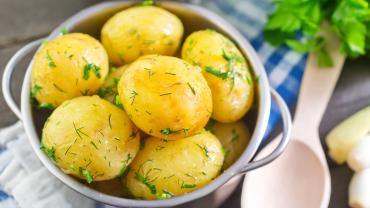
In a previous blog entitled “Sweet Potatoes or White Potatoes?” we explored the variances in nutrient composition and glycemic response of these beloved tubers. We concluded that the sweet potato may possess superiority in nutrient and antioxidant status but that the glycemic response (which has so often been the deciding factor in tossing out the white potato) is highly dependent on the method of preparation. Therefore a suggestion was posed that we should further explore the effect of various cooking methods on nutrient composition as well as the nutritional impact of the potato’s skin which is often thoughtlessly peeled and thrown in the trash but may actually house the greater portion of the potato’s nutrition.
It is doubtful that many individuals think about nutrition when deciding how they should cook that potato. Instead convenience texture appeal or culinary art may decide whether the fate of the tuber is the oven or the stovetop… diced sliced or mashed… hot or cold. Interestingly each of these different methods of preparation radically change the nutrition imparted to the consumer.
Preparation Method & the Glycemic Response
Boiling is a popular method of preparation and may be among the best choices for the combination of nutrient preservation and glycemic response. As mentioned in our previous post boiling a potato will gelatinize the starch inside the potato resulting in a lower glycemic response. How does this happen? Potato starch is composed of a complex of amylose (linear glucose chains) and amylopectin (branched glucose chains). Heat disrupts the bonds between these carbohydrate molecules allowing digestive enzymes better access to the independent structures which then combine with water molecules to form a gel. While amylopectin gets torn apart by enzymes and gelatinizes the strong hydrogen bonds of amylose renders it generally indigestible. The resulting resistant starch (amylose) provides a better glycemic response. This response is heightened when cooling occurs. Cooling gelatinized starch even further allowing some linear strands of amylopectin to align themselves parallel to amylose forming a larger structure of resistant starch and decreasing the bioavailability of glucose from amylopectin. Therefore boiled cooled potatoes provide the best glycemic response. Methods of preparation that do not utilize water such as baking and roasting do not allow the opportunity for gelatinization and the reforming of resistant starch complexes. In the absence of adequate resistant starch free glucose is accessible and ready to provide a glucose spike.
Preparation Method – Nutrient and Antioxidant Preservation
Boiling seems to preserve a greater percentage of the nutrient and antioxidant value of potatoes when compared to baking roasting or frying. Boiling requires less heat and is a gentler method of heating. Therefore heat-sensitive nutrients found in the skin and flesh are less likely to take a hit when boiled versus stuck in the hot oven. Despite being gentler boiling still results in some loss of heat-sensitive water-soluble vitamins such as vitamin C. Peeling potatoes prior to boiling or baking results in a greater loss of nutrients as the water-soluble nutrients in the flesh disperse in the cooking water.
Boiling especially preserves heat-sensitive nutrients within the flesh. Vitamins A C and K folate choline and select minerals such as calcium magnesium phosphorus and potassium are higher in boiled potato flesh compared to baked potato flesh. However baking retains more minerals and vitamins in the skin including vitamins A and C folate choline calcium magnesium phosphorus potassium and iron. It is evident that the vitamin and mineral chemical components and reactivity to water or oil can affect bioavailability.
Finally boiling colored potatoes that possess a high antioxidant value in their skin actually preserved a higher total phenolic content and antioxidant value compared to baked colored potatoes. Many of the phenolic compounds are fat-soluble which may explain why a water bath didn’t destroy as many antioxidants.
Potato Skins
The skins of all potatoes are the storehouse for most of the fiber vitamins and minerals provided by this otherwise starchy food. Therefore if nutrition is important in one’s decision of whether to keep potatoes on the menu it comes with the footnote that the skin must be included. One study that analyzed the nutrient distribution within tubers found higher concentrations of most minerals (with the exception of phosphorus and sulphur) in the skin of the potatoes. Iron is especially housed in the perimeter and accounts for nearly 55 percent of the iron content of potatoes. When considering antioxidant-rich nutrients one study noted that the skin of sweet potatoes contained nearly 10 times the amount of phenolic compounds found in the flesh. Although all methods of preparation greatly reduced the total phenolic content the skin still retained a high antioxidant capacity.
Some individuals have viewed potato skins with caution due to the presence of some toxic anti-nutritive compounds known as glycoalkaloids. These are present in potato skins to protect the tuber from fungi and insects. They are visible as the green coloring directly underneath the potato’s skin. Sensitive individuals remove the glycoalkaloids by peeling potatoes prior to cooking since cooking does not destroy these compounds. However it is still important to remember that the consumer is also peeling away a good portion of the potato’s nutrients leaving very little to desire except the flavor and comforting starch of the potato.
If potatoes are going to be included in one’s dietary plan it is of great benefit to make wise decisions regarding preparation so as to extract the maximum nutritional potential from these starchy roots. Overall boiling with the skin intact seems to be a better option for cooking colorful potatoes whose skin is a rich source of antioxidants while baking white potatoes with the skin intact may seem to preserve more nutrients in the skin. However when considering the glycemic response boiling may be the smarter choice of preparation for all forms of potatoes.